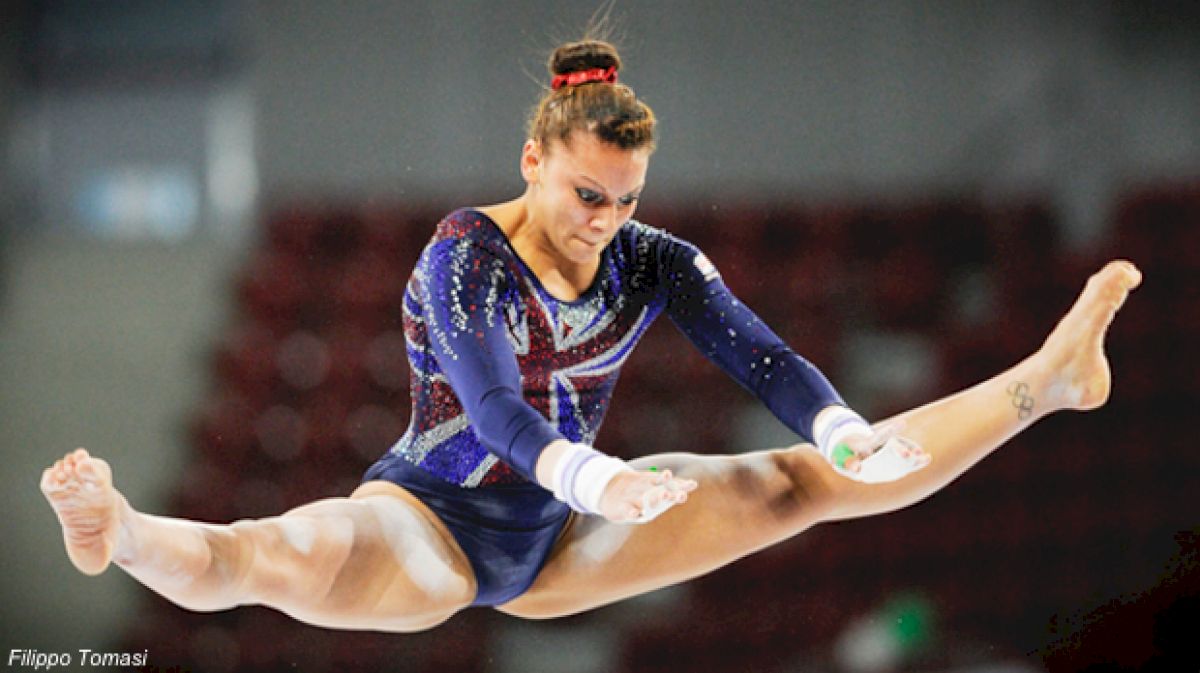What's The Difference: The Tkatchev Family
What's The Difference: The Tkatchev Family
What’s the difference between a Tkatchev, Ray, Hindorff, Ricna, Galante, Piked Tkatchev, Church, Shang, Downie and a Nabieva?

You know those skills where the gymnast swings around the high bar, lets go of it, flies impossibly high in the air with her legs perfectly positioned and her toes perfectly pointed and then catches it on the other side? Those are the Tkatchev skills, a family of skills done on the uneven bars with a seemingly exponential number of names and nuances. Here’s the gym-nerd’s guide to knowing your Tkatchev from your Ray, Galante, Ricna and all of the rest of them, because knowing those tiny, tricky differences makes watching gymnastics even more of a delight.
The Root Skill: The Tkatchev
Difficulty: D
The first Tkatchev was actually performed by a man, the Soviet gymnast Aleksandr Tkatchev, in 1977 at the Riga Cup. It begins with a backwards giant; the gymnast swings around the high bar, lets go, travels over the high bar in the straddle position and catches it on the other side. Elena Davydova, also of the Soviet Union, was the first woman to do it—she debuted it at the 1980 Olympic Games—but the name “Tkatchev” had already stuck.
What differentiates the Tkatchev from the other Tkatchev-adjacent skills are the entry (a giant, toe-on, stalder or inbar) and the flight (straddle, pike or layout). Here are the rest of the skills in the family.
Ray
Difficulty: D
The Ray is named after the American gymnast Elise Ray, who got it named for her at the 1999 World Championships. Instead of a giant, the Ray begins with a toe-on—the gymnast pikes her legs and touches her toes to the bar as she circles around it—but, like a Tkatchev, the flight is done in a straddle. Elise Ray was a particularly creative bar worker, and this was actually the second skill to be named after her; the first was a stalder shoot from the low bar to the high bar, and the third was a layout double double dismount.
Hindorff
Difficulty: E
The Hindorff, named for gymnast Silvia Hindorff of East Germany, was debuted at the 1978 World Championships; it was actually the first of the Tkatchev variations to be introduced to women’s gymnastics. It begins with a clear hip—where the gymnast circles around the bar with her hips at bar height—and, like the Tkatchev and Ray, has a straddled flight.
Ricna
Difficulty: E
The Ricna was first performed by gymnast Hanna Ricna of Czechoslovakia at the 1983 World Championships. It has a stalder entry, where the gymnast circles around the bar in a straddle position, and has a straddled flight, too. Some gymnasts maintain the straddle throughout, and some touch their toes together between the entry and flight—but both are still considered Ricnas.
Galante
Difficulty: E
Starting in 2009 code of points, release skills got an extra boost in value when connected with other elements in a bar routine, and we started seeing a lot more creativity in the Tkatchev space. Enter Italy’s Paola Galante, who got her skill named after her at the 2009 World Championships. The Galante has an inbar entry, where the gymnast pikes her legs deep enough that her feet go below the bar as she travels around it—and, like the Tkatchev, Ray and Hindorff, has a straddled flight.
Piked Tkatchev
Difficulty: E
The Piked Tkatchev, which doesn’t have its own special name, is exactly what it sounds like: it begins with a giant, just like a normal Tkatchev, but has the gymnast travel over the bar in a piked position, instead of a straddle. That pike shape bumps up the skill difficulty level from a D to an E.
Church
Difficulty: E
The Church is named for gymnast Shavahn Church of Great Britain, who debuted it at the 2005 World Championships. Like the Ray, the Church begins with a toe-on, but has the flight performed in the piked position.
Shang
Difficulty: F
Chinese gymnast Shang Chunsong is the woman behind the Shang, which was unveiled at the 2013 World Championships. It begins with a clear hip, just like the Hindorff, but has a piked flight instead of a straddle.
Downie
Difficulty: F
The 2010 World Championships brought us the Downie, a skill named for gymnast Rebecca Downie of Great Britain. It has the same entry as the Ricna—the stalder—but, like the Church and the Shang, has a piked flight.
Nabieva
Difficulty: G
Not to be one-upped, Russian gymnast Tatiana Nabieva also introduced her Nabieva at the 2010 World Championships. It’s a whopper of a G-level skill, with a toe-on entry and the flight done in a layout position—currently the only Tkatchev skill done in a layout, and once considered too risky to attempt.
Brette Warshaw is a freelance writer and consultant based in New York City. You can follow her at @bstarwarshaw.